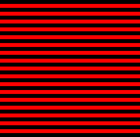- McCollough effect
-
 A second induction image for the McCollough effect. Stare at the centre of this image for a few seconds, then at the centre of the image above for a few seconds. Then return to this image. Keep looking between the two coloured images for at least 3 minutes.
A second induction image for the McCollough effect. Stare at the centre of this image for a few seconds, then at the centre of the image above for a few seconds. Then return to this image. Keep looking between the two coloured images for at least 3 minutes.
The McCollough effect is a phenomenon of human visual perception in which colorless gratings appear colored depending on (contingent on) the orientation of the gratings. It is an aftereffect requiring a period of induction to produce it. For example, if someone alternately looks at a red horizontal grating and a green vertical grating for a few minutes, a black-and-white horizontal grating will then look greenish and a black-and-white vertical grating will then look pinkish. The effect was discovered by Celeste McCollough in 1965.[1]
Contents
Producing the effect
To obtain the effect, first look at a test image similar to that at top right. It should contain oppositely oriented gratings of lines, such as horizontal and vertical as shown here. Next, stare alternately at two induction images similar to the ones directly beneath the top image. One image should show one orientation of grating (here horizontal) with a coloured background (red) and the other should show the other orientation of grating (here vertical) with a different, preferably oppositely coloured background (green). Each image should be gazed at for several seconds at a time, and the two images should be gazed at for a total of several minutes for the effect to become visible. Stare approximately at the centre of each image, allowing the eyes to move around a little. After several minutes, look back to the test image; the gratings should appear tinted by the opposite colour to that of the induction gratings (i.e., horizontal should appear greenish and vertical pinkish).
Properties of the effect
The McCollough effect is remarkable because it is long lasting. McCollough originally reported that these aftereffects may last for an hour or more.[1] They can last much longer than that, however. Jones and Holding (1975) found that 15 minutes of induction can lead to an effect lasting 3 months.[2]
The effect is different from colored afterimages, which appear superimposed on whatever is seen and which are quite brief. It depends on retinal orientation (tilting the head by 45 degrees makes the colors in the above example disappear; tilting the head by 90 degrees makes the colors reappear such that the gravitationally vertical grating now looks green), and because inducing the effect with one eye leads to no effect being seen with the other eye. However, there is some evidence of binocular interactions.[3]
Any aftereffect requires a period of induction (or adaptation) with an induction stimulus (or, in the case of the McCollough effect, induction stimuli). It then requires a test stimulus on which the aftereffect can be seen. In the McCollough effect as described above, the induction stimuli are the red horizontal grating and the green vertical grating. A typical test stimulus might show adjacent patches of black-and-white vertical and horizontal gratings (as above). The McCollough-effect colours are less saturated than the induction colours.
The induction stimuli can have any different colors. The effect is strongest, however, when the colors are complementary, such as red and green, and blue and orange. A related version of the McCollough effect also occurs with a single color and orientation. For example, induction with only a red horizontal grating makes a black-and-white horizontal test grating appear greenish whereas a black-and-white vertical test grating appears colourless (although there is some argument about that). Stromeyer (1978) called these non-redundant effects. According to him, the classic effect with induction from two different orientations and colours simply makes the illusory colors more noticeable via contrast.
The effect is specific to the region of the retina that is exposed to the induction stimuli. This has been shown by inducing opposite effects in adjacent regions of the retina (i.e., from one region of the retina verticals appear pink and horizontals appear greenish; from an adjacent region of the retina, verticals appear greenish and horizontals appear pink). Nevertheless, if a small region of the retina is exposed to the induction stimuli, and the test contours run through this region, the effect spreads along those test contours. Of course, if the induced area is in the fovea (central vision) and the eyes are allowed to move, then the effect will appear everywhere in the visual scene visited by the fovea.
The effect is also optimal when the thickness of the bars in the induction stimulus matches that of those in the test stimulus (i.e., the effect is tuned, albeit broadly, to spatial frequency). This property led to non-redundant effects being reported by people who had used computer monitors with uniformly colored phosphors to do word processing. These monitors were popular in the 1980s, and commonly showed text as green on black. People noticed later when reading text of the same spatial frequency, in a book say, that it looked pink. Also a horizontal grating of the same spatial frequency as the horizontal lines of the induction text (such as the horizontal stripes on the letters "IBM" on the envelope for early floppy disks) looked pink.
A variety of similar aftereffects have been discovered not only between pattern and colour contingencies, but between movement/colour, spatial frequency/colour and other relationships. All such effects may be referred to as McCollough Effects or MEs.[4]
Explanations of the effect
McCollough's paper sparked hundreds of scientific papers on the effect.[5][6]
Explanations of the McCollough effect appear to fall in to three camps.[1][4][7] McCollough indicated colour adaptation of edge sensitive neurons in lower, monocular regions of the visual cortex.[1]
A functional explanation of MEs has been posited in the form of an error-correcting device (ECD) whose purpose is to maintain an accurate internal representation of the external world. Consistent pairings of colour and oriented lines are not found frequently in natural environments, thus consistent pairing may indicate pathology of the eye. An ECD might compensate for such pathology by adjusting the appropriate neurons to a neutral point in adaptation to orientation contingent colour.[4]
A third explanation points to the contribution of classical conditioning to normal homeostatic regulation. MEs are explained by the same mechanisms as pharmacological withdrawal symptoms, thus the “pharmacological CR is expressed as pharmacological adaptation (tolerance) in the presence of the drug, and withdrawal symptoms in the absence of the drug” and the “chromatic CR is expressed as chromatic adaptation in the presence of colour, and the ME in the absence of colour”.[7] By this account MEs are of no adaptive value, but have been selected for as a domain-general ability to anticipate events.[7] This is related to Opponent-process theory.
It is worth noting that these theories do not predict or explain the Anti-McCollough Effect.[8]
Neurophysiological explanations of the effect have variously pointed to the adaptation of cells in the lateral geniculate nucleus designed to correct for chromatic aberration of the eye, to adaptation of cells in the visual cortex jointly responsive to color and orientation (this was McCollough's explanation) such as monocular areas of cortical hypercolumns, to processing within higher centers of the brain (including the frontal lobes[9]), and to learning and memory. In 2006, the explanation of the effect was still the subject of debate, although there was a consensus in favour of McCollough's original explanation.
MEs do not transfer interocularly[1][10] and from this it seems reasonable to deduce that the effect occurs in an area of the visual system prior to V1-4B, where binocular cells first occur.
The Anti-McCollough Effect
Recently, a new effect in the opposite direction of the McCollough effect was discovered and has been termed the anti-McCollough effect.[8] This effect may be induced by alternating pairings of gratings in parallel alignment, one achromatic (black and white) and the other black and a single colour (say black and red). If the colour used was red, then after the induction phase the achromatic grating appeared slightly red. This effect is distinct from the classical effect in three important regards; the perceived colour of the aftereffect is the same as the inducer's colour, the perceived colour of the aftereffect is weaker than the classical effect, and the aftereffect shows complete interocular transfer. Like the classic effect, the anti-McCollough effect (AME) is long lasting. Despite producing a less saturated illusory colour, the induction of an AME may override a previously induced ME.[8]
Given that AMEs do transfer interocularly[8] it is reasonable to suppose that they must occur in higher, binocular regions of the brain. Despite producing a less saturated illusory colour, the induction of an AME may override a previously induced ME, providing additional weight to the argument that AMEs occur in the higher visual areas than MEs.[8]
Explanations of the effect by adaptation of edge-detectors,[1] functional ECDs,[4] and classical conditioning[7] are compelling but will have to be adjusted for the inclusion of AMEs.
See also
References
- ^ a b c d e f McCollough, C. (1965). Adaptation of edge-detectors in the human visual system. Science, 149, 1115–1116.
- ^ Jones, P. D., & Holding, D. H. (1975). Extremely long-term persistence of the McCollough effect. Journal of Experimental Psychology: Human Perception & Performance, 1, 323–327.
- ^ White, K. D., Petry, H. M., Riggs, L. A., & Miller, J. (1978). Binocular interactions during establishment of McCollough effects. Vision Research, 18, 1201–12150.
- ^ a b c d Dodwell, P.C., Humphrey, K.G. (1990) A functional theory of the McCollough effect. Psychological Review, 97, 78-79.
- ^ McCollough, C. (2000). Do McCollough effects provide evidence for global pattern processing? Perception & Psychophysics, 62, 350–362.
- ^ Stromeyer, C. F. (1978). Color aftereffects dependent on form. In R. Held, H. W. Leibowitz, & H. L. Teuber (Eds.), Handbook of Sensory Physiology: Perception. Berlin: Springer-Verlag.
- ^ a b c d Allan, L.G., Siegel, S. (1998) Learning and Homeostasis: Drug Addiction and the McCollough Effect. Psychological Bulletin, 124, 230-239.
- ^ a b c d e Sheth, B., Shimojo, S. (2008) Adapting to an aftereffect. Journal or Vision, 29, 1-10.
- ^ Barnes, J., Howard, R. J., Senior, C., Brammer, M., Bullmore, E. T., Simmons, A., et al. (1999). Brain imaging: The functional anatomy of the McCollough contingent color after-effect. NeuroReport, 10, 195–199.
- ^ Allan, L.G., Siegel, S., Toppan, P. (1991) Assessment of the McCollough effect by a shift in the psychometric function. Bulletin of the Psychonomic Society, 29, 21-24.
External links
Categories:- Optical illusions
Wikimedia Foundation. 2010.


